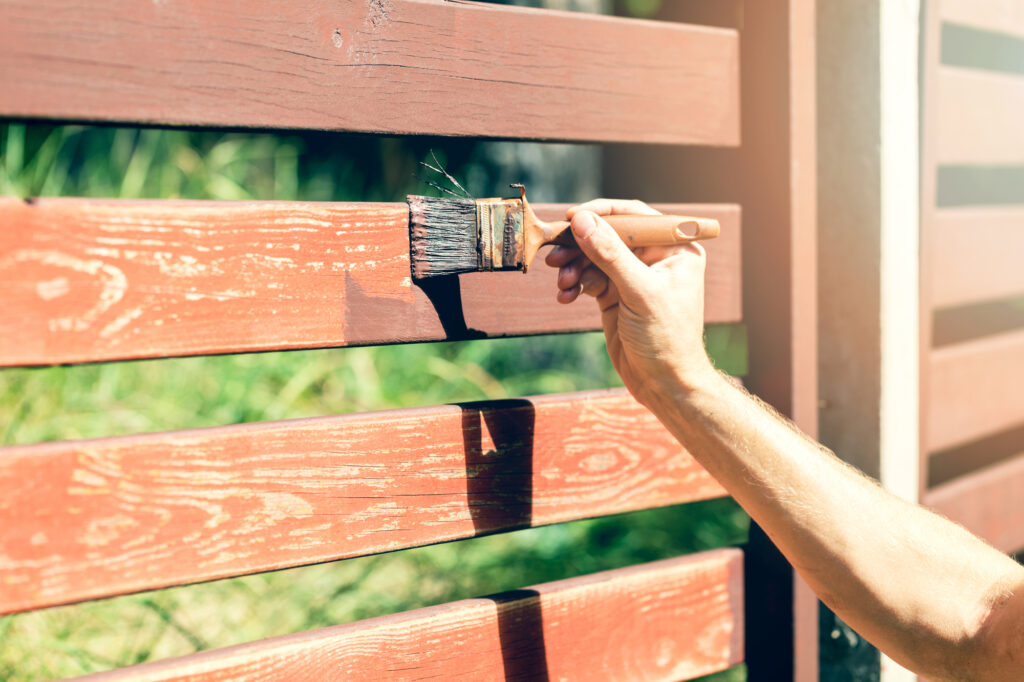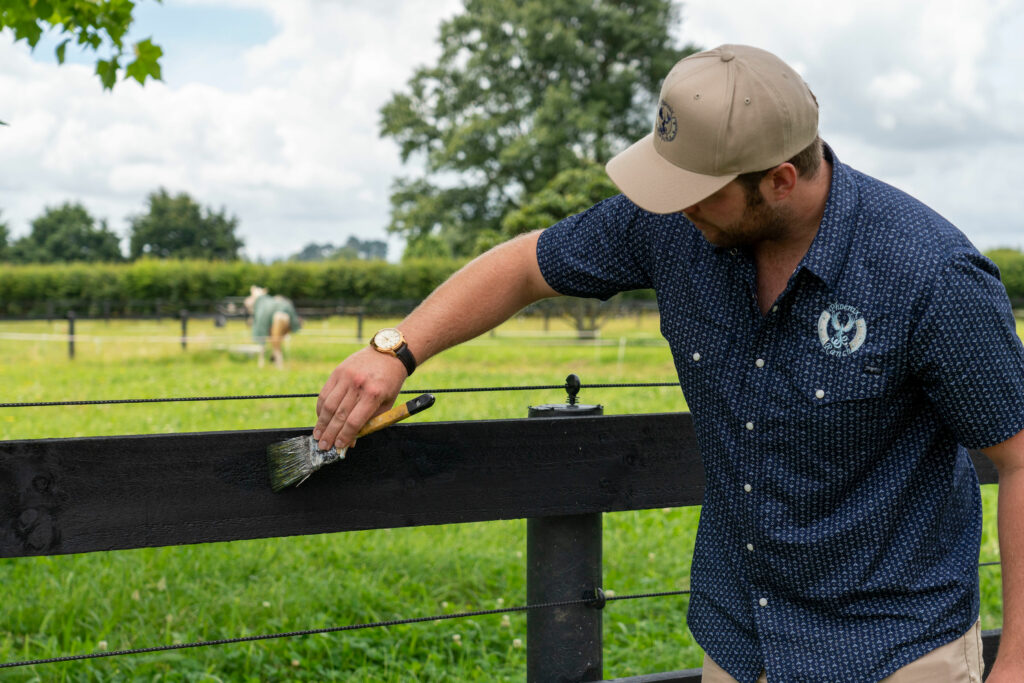Stock & Noble
What Are the Different Types of Timber Fence Stains
- BY Tripti Kakkar
Have you decided to give your timber fences a refresh with fence stains, but are feeling overwhelmed by all the different options? Then keep reading.
Taking up a fence makeover project is a task in itself. With all the time, money and effort invested in it, you surely don’t want to regret the choice later. For that to happen, the most important step is to gather all the right and relevant information about fence stains.
At Stock & Noble, we provide the finest fencing solutions to premium property owners across Australia and New Zealand. Our range of fence paints and stains is developed by experts based on years of research to give you long-lasting and the most beautiful-looking fences. While we love our paints, we know that they might not match the needs and budget of each and every property owner. We aim to help you create a property the way you always imagined and will equip you with key insights and knowledge to make the right decision.
In this blog, we will discuss different types of fence stains, their application and specifications, so that you have in-depth information on each kind and know which one would match your timber and your vision the best.
Timber fence stains offer a variety of options to suit different preferences and needs. We will explore each type in detail and you will be able to make the right decision for beautiful long-lasting fences.
Types of Fence Stains Based on Formulation
1. Water-Based Fence Stains
Water-based stains are a popular choice for timber fences due to their ease of application and environmental friendliness. These stains contain water as the primary solvent, making them low in volatile organic compounds (VOCs) and safer to use. They are available in a wide range of colours, allowing you to achieve the desired look for your fence.
Advantages of water-based stains:
Ease of Application: Water-based stains are easy to apply with a brush, roller, or sprayer, and they dry quickly, allowing you to complete your staining project in less time.
Low Odour: Compared to oil-based stains, water-based stains have a milder odour, making them more pleasant to work with, especially in enclosed or indoor spaces.
UV Protection: Many water-based stains contain UV inhibitors that help protect the wood from sun damage, reducing the risk of fading and discolouration over time.
Environmentally Friendly: Water-based stains have lower VOC emissions, making them a greener choice for environmentally conscious property owners.
2. Oil-Based Fence Stains
Oil-based stains are known for their deep penetration into the wood fibres, providing long-lasting protection and enhancing the natural beauty of the wood grain. These stains contain oils such as linseed oil or alkyd resin as the primary solvent, allowing them to penetrate deeply into the wood and create a durable, moisture-resistant barrier.
Advantages of oil-based stains include:
Deep Penetration: Oil-based stains penetrate deep into the wood, nourishing and protecting the fibres from within. This helps to prevent moisture absorption and minimize the risk of rot, decay, and warping.
Rich Colour: Oil-based stains enhance the natural beauty of the wood, enriching its colour and highlighting the grain patterns for a stunning visual effect.
Longevity: Oil-based stains provide long-lasting protection against weathering, UV damage, and wear and tear, making them ideal for timber fences in harsh outdoor environments.
Versatility: Oil-based stains can be used on a variety of wood species and surfaces, including hardwoods, softwoods, and pressure-treated timber, making them suitable for a wide range of fencing projects.
If you want to dig deeper, check out a detailed guide on oil-based vs. water-based stains for timber fences.
Understanding Fence Stains based on Quantity of Pigment
1. Semi-Transparent Stains
Semi-transparent fence stains offer a balance between colour enhancement and wood grain visibility, allowing the natural beauty of the wood to shine through while adding a subtle tint to enhance its appearance. These stains contain pigments that penetrate the wood, providing moderate protection against the elements while allowing the wood’s texture and character to remain visible.
These stains have a low pigment level, allowing the wood grain to show through while still adding some colour to the surface. They’re a great choice if you want a bit more colour without completely covering up the wood.
Stock & Noble Stain Fence Stains belong to this category as water-based; oil-modified polyurethane stains formulated for all types of timbers. The penetrating semi-transparent finish delivers excellent UV resistance combined with water repellence and anti-mould properties.
Advantages of semi-transparent stains include:
Natural Appearance: Semi-transparent stains maintain the natural look and feel of the wood, allowing its grain patterns and texture to show through for a rustic, authentic appearance.
Subtle Colour Enhancement: Semi-transparent stains add colour to the wood without completely obscuring its natural beauty, providing a subtle tint that enhances its appearance while preserving its rustic charm.
Weather Protection: Newly developed semi-transparent stains offer good protection against UV damage, moisture, and mildew, helping to prolong the life of your timber fence.
Easy Maintenance: Semi-transparent stains are easy to maintain and touch up as needed, making them a practical choice for homeowners who value convenience and simplicity.
2. Solid Fence Stains
Solid stains, also known as opaque stains, provide maximum colour coverage and protection, creating a uniform finish that hides imperfections and provides long-lasting durability. These stains contain a high concentration of pigments that form a solid film on the wood surface, covering the grain and texture for a bold, vibrant appearance.
These stains are great for fences with lots of wear and tear, as they hide much of the wood’s grain and provide extra protection. They’re ideal for older wood that needs a bit of extra TLC.
Advantages of solid stains include:
Uniform Coverage: Solid stains cover the wood surface completely, hiding imperfections such as knots, cracks, and discolouration for a smooth, uniform finish.
Vibrant Colour: These stains come in a wide range of colours, from earthy neutrals to bold, vibrant hues, allowing you to customise the look of your fence to suit your style and preferences.
Maximum Protection: Solid stains provide superior protection against UV damage, moisture, and weathering, helping to extend the life of your timber fence and maintain its appearance for years to come.
Versatility: They can be used on a variety of wood species and surfaces, making them suitable for properties where durability and weather resistance are essential.
3. Clear or Transparent Fence Stains
Clear fence stains or sealers enhance the natural beauty of the wood without adding colour, providing protection against moisture, UV rays, and mildew. These sealers contain water-repellent additives and UV inhibitors that penetrate the wood, forming a transparent barrier that helps to prevent warping, cracking, and fading.
However, the more transparent the stain is, the less UV protection it might offer. UV inhibitors have a level of colour and when mixed with the stain they create a non-natural look. Therefore, in some brands of fence stains if you choose colour, you get better UV protection, while the more natural/transparent look you go for, the amount of UV inhibitors and the protection also goes down.
The new Semi-transparent stains that are now being developed, for instance, Stock & Noble Forever Stains, offer a higher level of UV protection. so it’s best to check with your supplier about the formulation of the stain and the level of protection it provides.
These stains are barely visible and let the natural beauty of the wood shine through. They’re perfect if you want to show off the wood’s grain and texture.
Advantages of clear stains include:
Natural Appearance: Clear fence stains maintain the natural look and feel of the wood, allowing its grain patterns and texture to show through for a clean, understated appearance.
Enhanced Durability: They provide protection against moisture, UV damage, and mildew, helping to prolong the life of your timber fence and maintain its appearance for years to come.
Easy Application: Clear fence stains are easy to apply with a brush, roller, or sprayer, and they dry quickly, allowing you to complete your sealing project in less time.
Low Maintenance: Clear stains are easy to maintain and touch up as needed, making them a practical choice for property owners who value convenience and simplicity.
Ready to Choose the Best Stain for Your Timber Fences?
You wanted to give your fences a new look with fence stains and needed information regarding different types available in the market today. Now you know there are different types of fence stains based on formulation and pigment levels.
You can confidently take the first step of choosing between water-based and oil-based fence stains and then move on to take your pick from clear, semi-transparent and solid stains.
It’s worth noting that all three (clear, semi-transparent and solid) fence stains are available in oil as well as water-based formulations.
So, what’s the best stain for your wood fence? It depends on how much of the wood’s grain you want to show off:
- Go for a transparent, semi-transparent, or clear stain if you have a newer fence and want to show off the grain.
- If your fence has seen its fair share of use, go for a semi-solid stain, as it will hide the wear and tear while still allowing some of the grain to be visible.
- Solid stains are best if your fence has many imperfections or if you desire a specific colour.
By understanding the spectrum of timber fence stains and considering the level of visibility you want for your wood’s grain, you can pick the perfect stain to keep your fence looking fabulous for years to come. The next step is to learn how to apply fence stains on your timber fences.
If you have more questions on stains or other fence coatings including premium paints and primers, feel free to connect with an expert. Our team is here to help you every step of the way to create a beautiful property, you’re truly proud of.




